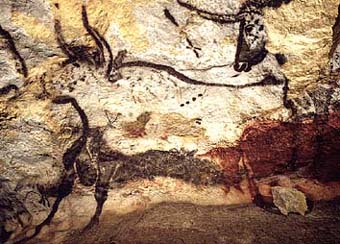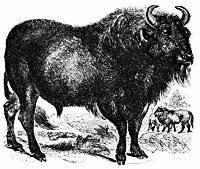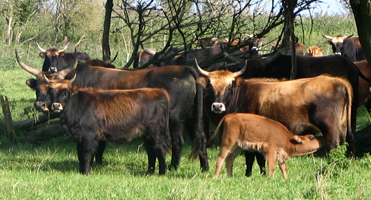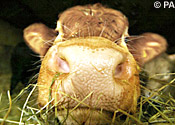
April 21, 2009

The aurochs or urus (Bos primigenius) was a very large type of cattle that was prevalent in Europe until its extinction in 1627.

Now a breed of giant cattle created by the Nazis can be seen in Britain for the first time after a farmer imported the huge creatures to graze conservation land.

The Heck Cattle (shown above) were created by Adolf Hitler’s geneticists because the dictator wanted to bring back to life the extinct aurochs, a legendary breed believed to be the size of a rhino.
The aurochs were hunted to extinction in the early 17th century and before the Second World War zoologist brothers Heinz and Lutz Heck attempt to bring them back by breeding from modern cattle.
They created the Heck breed but the animal was seen as a symbol of efforts to build a master Aryan race and most were destroyed after the war.
A small number survived and now 13 are living in Devon where farmer Derek Gow hopes to use them for grazing as well as in wildlife photography and film-making courses.
The 44-year-old, who runs Upcott Grange Farm near Lifton, said: “We will be breeding to create a small pedigree herd which will hopefully be used for nature conservation grazing.
“The Nazis wanted to recreate the auroch to evoke the power of the folklores and legends of the Germanic peoples.
“Aurochs were wild bulls, Julius Caesar recorded them as being bulls as big as elephants.
“Young men hunted these bulls as preparation for battle and leadership in war, but also to obtain these huge 6ft-wide horns that the bulls had as drinking vessels and war horns. They were huge trophies.”
Mr Gow said the bulls were used as a propaganda motif by the Fascist regime and the Heck was a mix of breeds from the Scottish Highlands, Corsica and the French Camargue, as well as Spanish fighting bulls.
He said: “The auroch was extinct, but domestic descendants – Friesians, Simmentals and everything else – were still kicking around the countryside.
“The two brothers argued that if the one wild animal that spawned all of these had gone, through a process of back-breeding domestic cattle, you could pull the wild genes out and recreate the ancestor.”
Mr Gow said his Heck cattle, which were quarantined, were much shorter than the aurochs, but they did retain the muscular build, deep brown complexion and shaggy, coffee-coloured fringe.
He said: “They look like the cave paintings of Lascaux and Altamira.
“It makes you think of the light of a tallow lamp and these huge bulls on these cave paintings leaping out at you from darkened walls.”

If you have an extra 10 Euros or American dollars, please know that any amount from you builds to what is needed for the museum. Do remember to…
🙂 Thank You!
About Loren Coleman
Loren Coleman is one of the world’s leading cryptozoologists, some say “the” leading living cryptozoologist. Certainly, he is acknowledged as the current living American researcher and writer who has most popularized cryptozoology in the late 20th and early 21st centuries.
Starting his fieldwork and investigations in 1960, after traveling and trekking extensively in pursuit of cryptozoological mysteries, Coleman began writing to share his experiences in 1969. An honorary member of Ivan T. Sanderson’s Society for the Investigation of the Unexplained in the 1970s, Coleman has been bestowed with similar honorary memberships of the North Idaho College Cryptozoology Club in 1983, and in subsequent years, that of the British Columbia Scientific Cryptozoology Club, CryptoSafari International, and other international organizations. He was also a Life Member and Benefactor of the International Society of Cryptozoology (now-defunct).
Loren Coleman’s daily blog, as a member of the Cryptomundo Team, served as an ongoing avenue of communication for the ever-growing body of cryptozoo news from 2005 through 2013. He returned as an infrequent contributor beginning Halloween week of 2015.
Coleman is the founder in 2003, and current director of the International Cryptozoology Museum in Portland, Maine.
Filed under Breaking News, CryptoZoo News, Weird Animal News